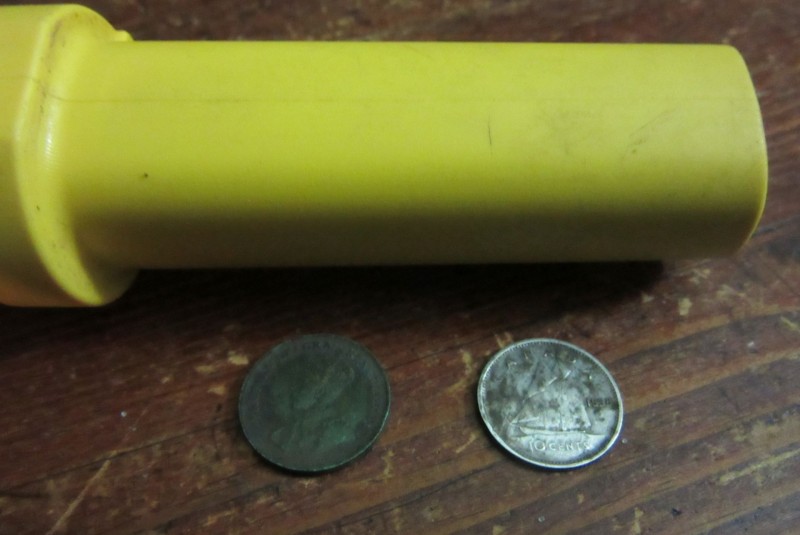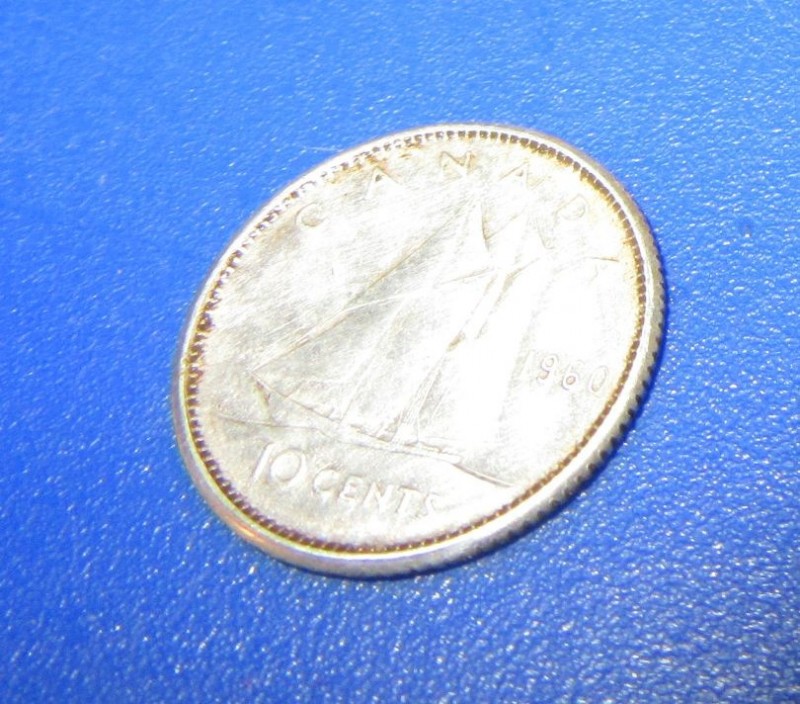-
Posts
514 -
Joined
-
Last visited
Content Type
Forums
Detector Prospector Home
Detector Database
Downloads
Everything posted by cjc
-
The sense I get with this upgrade is that you could draw two "bias curves". The F--is lower and flatter--not quite beginning to break up the range of caps--but there are fewer consequences. It also attempts to bring them into the center of the ID scale for a more defined ID. F2 is a steeper curve that does get the entire range of caps but carries with it your typical high bias tradeoff--sluggishness around iron and alloys as all this filtering takes place in software. At the higher levels Recovery Speed does not seem to do nearly as much. While its pretty good at higher levels on "clean" metals such as high kt gold, just as with any "power curve" there is still a loss of overall effectiveness at the higher ranges--where the audio becomes a bit corrupted--the bias takes up a lot of the machine's "work" capacity. Where you are trying to tame diverse fq's to begin with--adding the muting of a scattered type of target (caps) has got to involve "dialing back" the machine's ability to detect all targets. I think the way to get the most from this upgrade is to run a low setting but then--practice speeding up the sweep to knock out a higher range of caps and iron. It's great to have this additional tool to run extreme high bias but there are for sure some tradeoffs to be managed. cjc
-
seems pretty good to me especially when you get up around 4 or 5. it's the part with the tradeoffs....seems like clean, smooth bias though--a clean signal does not seem to suffer that much at least at those mid settings. cjc
-
Eric Foster worked with them on some of their boards the CS6--A very sharp PI circuit. In fact when I ask some of the best bench techs I know what they are working on several have said that their projects have this platform as a basis. cjc
-
...more bearded guys...running around..... ...oh brother... cjc
-

Noise / Falsing While Hunting In Saltwater
cjc replied to Ferrous Grump's topic in Minelab Equinox Forum
This is a great and interesting topic that encompasses a large number of the things that the Equinox does. To address this problem --there isn't a single "tweak' it takes a full understanding of detector basics and then specific knowledge of how to apply these basics to the Equinox. The main culprits are high salinity, bottom contours (including inclines) and fast water. There are some good tips in the manual--a faster Rec. Spd. as offset by more sens and Ground Balancing with a side to side "boost." I've also used something that draws from my Excal days--recognising that there are three distinct "zones" in many salt environments--the high "draw", the "lower swish" and the lower flat--each with different balance points. To move the coil while you balance is really just bringing in more randomness. Making for a higher balance point. It's not a bad idea to balance for and hunt these three "zones" separately--so as not to be over balanced for the less challenging levels. I've done a fair bit of testing with the Rec. Spd. dynamic and while some of the speeds I see suggested here (3,4) are pretty low, when you do go up higher there is a risk of depth loss. This is more of an extreme measure--good for hills or rough bottom terrain. How increased Gain factors in here is a tough call--conditions dependent. Trying to get more depth by clipping down a high powered signal doesn't really make sense when you look at the "bitty" audio that signals the Equinox not handling fast or deep salt.... My strategy is just to bring up the TB enough to assign more ground noises down. (1 or 2) I've also experimented with some overtuning methods (Manual -9) that seem to help as well--producing a general smoothing effect with good responses standing out more. I also run 2 Tone--to simplify things. An alternate for the 800 is to use the "Pitch Gap" in 50 Tone. These two methods allow decent Gain settings and let me avoid this constant chasing of half sounds. Sweep speed gives some lee-way to respond to changes instead of some high Rec Spd. Too many hunters think that the Equinox will "quick tweak" for any situation--whereas no detector can. It takes trial and error and a broad based approach to tuning to address the demands of a fast, varied salt environment. cjc cjc -

Noise / Falsing While Hunting In Saltwater
cjc replied to Ferrous Grump's topic in Minelab Equinox Forum
Sorry about the abbreviations--I hear others calling them as such and do it myself without thinking. Not on Geotech here wherein I would be the one asking for clarification.... cjc -

Noise / Falsing While Hunting In Saltwater
cjc replied to Ferrous Grump's topic in Minelab Equinox Forum
-

Noise / Falsing While Hunting In Saltwater
cjc replied to Ferrous Grump's topic in Minelab Equinox Forum
Dave's Salt Water Report Card was an accurate and well written account. I bookmarked this as kind of a "problem set" for future projects in the NOX. Never liked the "bitty" quality that the audio takes on in fast or deep salt or where there are inclines. The overprocessed signal removes you from the feedback that needs to be responded to by way of coil speed and tuning. I guess this is why there is the low TX shift--so new hunters would not be at a total loss. There's also the problem of ground noises jumping up. Best thing I've found is to run B2 in 2 Tone with a massive manual undertune (-9!). This gives more of a solid barrier--and cleaner assignment of targets. It can also be run in All Metal this way to make good responses stand out. You also have TB to clean up the signal if needed. Not my first choice as a deep salt water machine but it works and is accurate. cjc -

Thoughts On CTX And Equinox After Long Term Use
cjc replied to Daniel Tn's topic in Minelab Equinox Forum
-
This is a well made, well thought out and extremely deep, powerful detector. The switchable frequencies (5/ 14 & 20 kHz) and make it super versatile in any conditions. All programs and features are visible on screen--simple to customize for the novice but with the most advanced discriminate and tough ground features available. Unbelievable to have this kind of power and fidelity in a water machine! Also--the best audio of any machine I've used--great separation in iron and the new 10" coil is a great addition. Love this detector!! cjc
-

A Quick Look At The Nokta / Makro Pulse Dive
cjc replied to cjc's topic in Nokta / Makro Metal Detectors
Ya, I really like this product too. These kinds of situations where a perfect signal is wedged in coral or hardpan need this device. The more I test it the more I see it going deeper in ground. That down on the belly work is super tough--especially in current. Guy who saw this post on my FB showed me a PP'er with the same extension--he feels for the vibration up the handle. cjc -

A Quick Look At The Nokta / Makro Pulse Dive
cjc replied to cjc's topic in Nokta / Makro Metal Detectors
I would say in air small tip 4 -5 " large tip 6"+ but one thing that Bill Lahr tells me all the time is that a pulse will go deeper in ground--especially salt. Seems pretty powrfull compared to some of the other PP'ers I've tried especially with the dive coil. Seems to reach out pretty well on larger targets too. Really like the sound and in-ground performance. cjc -
A Quick Look at The Nokta / Makro Pulse Dive I was fortunate enough to field test a prototype of this amazing device and was immediately impressed by the Pulse Dive’s rugged, professional feel. The solid “heft” of the device made all other pinpointers I’ve tried feel like flimsy toys. It’s also a great, practical concept—a waterproof diving detector with a deep 5.5” (14 cm.) coil for that converts in a second to a regular pinpointer. The Pulse Dive features 5 levels of Sensitivity adjustment, selectable vibration, light and tone alert and can be paired with your headphones via a built-in wireless module. The production model features yellow detail for easy visibility underwater and comes in a sturdy case. The Pulse Dive kit includes covers for both coils, holster, lanyard, spare gaskets, charge cord and manual. There's also a second, louder endcap for land use. This is an extremely well-thought-out device—great not only as a deep, full featured standard pinpointer but also for quick area searches of dwellings, stone walls, enclosed spaces--and even as a security wand. My tests showed the Pulse Dive to have great sensitivity to small gold—even chains. It also had nice depth for coin hunting on land. Picture shows a ’32 cent and '38 nickel—my first two finds pinpointed with the Pulse Dive. A great addition to any serious inland or shoreline treasure hunter’s kit. cjc
-
no it was like the clips wore and let water in upgraded gasket or not. it was an old model. seems pretty good now but will do some time in the tub before i trust it in salt. cjc
-
ya, I had a new bulkhead cell and clips put in and it leaked right away (mismatched clips?) right up into the control pod and would not boot but ML did me a very nice turn and gave me some seconds clips snap very nicely now looks pretty good. hope they do in fact have their act together with this one--great machine these minor things gave it a bad name amongst many and almost me too.. clc
-
Always appreciate hearing your spin on things Dewcon. It is amazing just how much of this low end wrap this detector has--thats why I have no hesitation in running the TB up a bit to shut it up and reduce these partials. Amazing that these will not even be iron just seabed. Some will be way up at 9 that's too high. Ive been testing an "undertune" (-9) prog that works well at making good responses stand out well. Chase is right on with suggesting not straying too far from the stock settings especially RS--as you say it either flattens or chops. Hunted with the EQ as a pro last week and although the coil went it did quite well. Taking some early notes for a V3 and realize that V's 1 & 2 did not address these issues nearly well enough. You really need to have a good grasp of how Sens, GB, RS and Bias interact to get performance from this detector in deep salt water---especially if you want to hear any faint targets over this "racket". cjc
-
Chase--that's pitch--takes some getting used to but it's the most distinct. I typically run the TB at around 2 --not really expecting any micro gold well worth the trade off in stability. Cant be heard underwater--real flaw IMHO---just no volume. cjc
-
As much as M/L wants to portray the EQ as "turn on and go" these machines with a complex, highly processed (modulated) signal are finicky and there's a fair bit to learn in order to get consistent performance--especially around salt. Keeping the Sens within a manageable range is the only way to really learn the machine. Another good method is to crank it and get used to picking responses out--then when you turn it back down the audio is easier to recognize especially the faint range. cjc
-
Great rundown and instruction, Chase. I especially like the part about letting the machine operate within its pre-set parameters. Very good advice. Thanks clive
-
My spin is this: with a single frequency machine there's more of a tendency to be noisy in fast salt. With the EQ--targets are more in the background. There's also a "bittyness" to the audio when it's not handling well. Ive done okay with it in B2 2 tone with the NF tone at 25 and if its making noise the TB jacked up to above zero. Also I've been testing an "undertune" prog that keeps the GB way down at -9. Seems to make targets stand out a little better. Its no CTX thats for sure. In ground where a pulse would be noisy no VFL gets off scott free--there's always a price to be paid whether you notice it or not. Certainly not thrilled about a machine for the water that can't be heard underwater... cjc
-

Got The Anfibio Into Some Iron Today! Wow!
cjc replied to cjc's topic in Nokta / Makro Metal Detectors
In looking for silver what I like about this machine is that as you adjust the high tone break there's a nice high tone that comes in initially but then drops out if the signal is below your setting. So you are still getting stuff in close to iron but can use the coil to tell what's what. You hear both ranges at once. Gotta get some more practice upping the high tone--pitch and volume. I know there's going to be a lot of silver this year. Its also shocking how many good signals are coming out of nowhere at the same sites I'd given up on. cjc -

Got The Anfibio Into Some Iron Today! Wow!
cjc replied to cjc's topic in Nokta / Makro Metal Detectors
There's a lot going on with the bias and gain--more tones is too much initially. Once you understand the iron response though--lot of potential anywhere. Killed my worst site the other day..a Victorian grove where they worked on cars later on. Kind of a cleaner, sharper signal than any of the multis--none of this "doodley boop" or bittyness....the Anfibio is raw--but stable. Feel like it's wide open now --got an 1870 dime there a while back. cjc -

Reviewing Tony Eisenhower's Headphones For The Equinox
cjc replied to cjc's topic in Minelab Equinox Forum
M/L, Harolds (with a jumper from CTX), GG Amphibians (not terrible) and TE's (best). cjc -
Finally a thaw here had a chance to run this detector in the iron at some old sites. Very impressed with the new coil --makes the machine considerably deeper than even the Impact and Kruzer. Superb audio as well--I can really hear everything in the ground--set at disc zero the heavy iron areas become obvious telling me where to buzz around for masked targets. Or I can just jump it up to 4 or 5 to knock the spikes out. With this detector I can hear anything non-ferrous mixed in really well. The 3 Tone mode is also great--it's speeds up the response to bring up even more signals from these worst sections. Never really felt the need for a pinpointer but with the way this machine gets down into the spikes I will need one now. Really liked the overall performance of this detector and will be out there again heading for the worst sections soon as it warms up a bit. cjc




